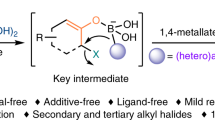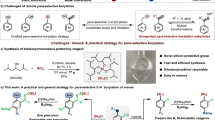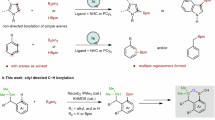Abstract
Traditional metal-catalysed cross-couplings of alkyl halides for C(sp3)–C(sp2) bond formation are often challenging to achieve. Processes where the alkyl halide is initially converted into a radical species can provide valuable complementarity. So far, these strategies are almost exclusively orchestrated by silicon-based reagents, which can be expensive, have low atom economy and are sensitive to steric factors. Here we report the use of the stable Lewis acid–Lewis base complex Me3N–BH3, which, upon conversion into its corresponding amine-ligated boryl radical, enables nickel- and copper-catalysed cross-coupling of alkyl iodides and bromides with electrophilic aryl bromides and nucleophilic aryl boronic acids. Mechanistically, this method uses the amine borane radical’s propensity to activate halides via halogen-atom transfer through highly polarized transition states. This reactivity features mild conditions and broad tolerability of functional groups and engages sterically hindered alkyl halides.





Similar content being viewed by others
Data availability
The authors declare that all relevant data supporting the findings of this study, including experimental procedures, compound characterization, computational study details, NMR spectra and other spectroscopic analysis, are available within the paper and its Supplementary Information.
References
Smith, J. M., Harwood, S. J. & Baran, P. S. Radical retrosynthesis. Acc. Chem. Res. 51, 1807–1817 (2018).
Pitre, S. P., Weires, N. A., Overman, L. E. & Forging C(sp3)–C(sp3) bonds with carbon-centered radicals in the synthesis of complex molecules. J. Am. Chem. Soc. 141, 2800–2813 (2019).
Crespi, S. & Fagnoni, M. Generation of alkyl radicals: from the tyranny of tin to the photon democracy. Chem. Rev. 120, 9790–9833 (2020).
Jasperse, C. P., Curran, D. P. & Fevig, T. L. Radical reactions in natural product synthesis. Chem. Rev. 91, 1237–1286 (2002).
Perez Garcia, P. M., Di Franco, T., Epenoy, A., Scopelliti, R. & Hu, X. From dimethylamine to pyrrolidine: the development of an improved nickel pincer complex for cross-coupling of nonactivated secondary alkyl halides. ACS Catal. 6, 258–261 (2016).
González-Bobes, F. & Fu, G. C. Amino alcohols as ligands for nickel-catalyzed Suzuki reactions of unactivated alkyl halides, including secondary alkyl chlorides, with arylboronic acids. J. Am. Chem. Soc. 128, 5360–5361 (2006).
Zhou, J. & Fu, G. C. Suzuki cross-couplings of unactivated secondary alkyl bromides and iodides. J. Am. Chem. Soc. 126, 1340–1341 (2004).
Campeau, L.-C. & Hazari, N. Cross-coupling and related reactions: connecting past success to the development of new reactions for the future. Organometallics 38, 3–35 (2019).
Kambe, N., Iwasaki, T. & Terao, J. Pd-catalyzed cross-coupling reactions of alkyl halides. Chem. Soc. Rev. 40, 4937–4947 (2011).
Twilton, J. et al. The merger of transition metal and photocatalysis. Nat. Rev. Chem. 1, 0052 (2017).
Murarka, S. N-(acyloxy)phthalimides as redox-active esters in cross-coupling reactions.Adv. Synth. Catal. 360, 1735–1753 (2018).
Torres, G. M., Liu, Y. & Arndtsen, B. A. A dual light-driven palladium catalyst: breaking the barriers in carbonylation reactions. Science 368, 318–323 (2020).
Julia, F., Constantin, T. & Leonori, D. Applications of halogen-atom transfer (XAT) for the generation of carbon radicals in synthetic photochemistry and photocatalysis. Chem. Rev. 122, 2292–2352 (2022).
Chatgilialoglu, C., Ferreri, C., Landais, Y. & Timokhin, V. I. Thirty years of (TMS)3SiH: a milestone in radical-based synthetic chemistry. Chem. Rev. 118, 6516–6572 (2018).
Ruffoni, A., Mykura, R. C., Bietti, M. & Leonori, D. The interplay of polar effects in controlling the selectivity of radical reactions. Nat. Synth. 1, 682–695 (2022).
Curran, D. P., Bosch, E., Kaplan, J. & Newcomb, M. Rate constants for halogen atom transfer from representative.alpha.-halo carbonyl compounds to primary alkyl radicals. J. Org. Chem. 54, 1826–1831 (2002).
Curran, D. P., Jasperse, C. P. & Totleben, M. J. Approximate absolute rate constants for the reactions of tributyltin radicals with aryl and vinyl halides. J. Org. Chem. 56, 7169–7172 (2002).
Lavagnino, M. N., Liang, T. & MacMillan, D. W. C. HARC as an open-shell strategy to bypass oxidative addition in Ullmann–Goldberg couplings. Proc. Natl Acad. Sci. USA 117, 21058–21064 (2020).
Zhang, P., Le, C. C. & MacMillan, D. W. Silyl radical activation of alkyl halides in metallaphotoredox catalysis: a unique pathway for cross-electrophile coupling. J. Am. Chem. Soc. 138, 8084–8087 (2016).
Everson, D. A., Shrestha, R. & Weix, D. J. Nickel-catalyzed reductive cross-coupling of aryl halides with alkyl halides. J. Am. Chem. Soc. 132, 920–921 (2010).
Everson, D. A., Jones, B. A. & Weix, D. J. Replacing conventional carbon nucleophiles with electrophiles: nickel-catalyzed reductive alkylation of aryl bromides and chlorides. J. Am. Chem. Soc. 134, 6146–6159 (2012).
Paul, A., Smith, M. D. & Vannucci, A. K. Photoredox-assisted reductive cross-coupling: mechanistic insight into catalytic aryl–alkyl cross-couplings. J. Org. Chem. 82, 1996–2003 (2017).
Mann, A. in The Practice of Medicinal Chemistry 3rd edn (ed. Wermuth, C. G.) 363–379 (Academic Press, 2008).
Zeng, X. et al. Aryl radical enabled, copper-catalyzed sonogashira-type cross-coupling of alkynes with alkyl iodides. ACS Catal. 13, 2761–2770 (2023).
Cai, A., Yan, W., Wang, C. & Liu, W. Copper-catalyzed difluoromethylation of alkyl iodides enabled by aryl radical activation of carbon–iodine bonds. Angew. Chem. Int. Ed. 60, 27070–27077 (2021).
Cai, A., Yan, W. & Liu, W. Aryl radical activation of C–O bonds: copper-catalyzed deoxygenative difluoromethylation of alcohols. J. Am. Chem. Soc. 143, 9952–9960 (2021).
Caiger, L., Zhao, H., Constantin, T., Douglas, J. J. & Leonori, D. The merger of aryl radical-mediated halogen-atom transfer (XAT) and copper catalysis for the modular cross-coupling-type functionalization of alkyl iodides. ACS Catal. 13, 4985–4991 (2023).
Constantin, T. et al. Aminoalkyl radicals as halogen-atom transfer agents for activation of alkyl and aryl halides. Science 367, 1021–1026 (2020).
Rablen, P. R. Large effect on borane bond dissociation energies resulting from coordination by Lewis bases. J. Am. Chem. Soc. 119, 8350–8360 (1997).
Baban, J. A. & Roberts, B. P. An electron spin resonance study of phosphine-boryl radicals; their structures and reactions with alkyl halides. J. Chem. Soc. Perkin Trans. 2, 1717–1722 (1984).
Baban, J. A., Marti, V. P. J. & Roberts, B. P. Ligated boryl radicals. Part 2. Electron spin resonance studies of trialkylamin–boryl radicals. J. Chem. Soc. Perkin Trans. 2, 1723–1733 (1985).
Ueng, S.-H. et al. Complexes of borane and N-heterocyclic carbenes: a new class of radical hydrogen atom donor. J. Am. Chem. Soc. 130, 10082–10083 (2008).
Walton, J. C. et al. EPR studies of the generation, structure, and reactivity of N-heterocyclic carbene borane radicals. J. Am. Chem. Soc. 132, 2350–2358 (2010).
Kim, J. H. et al. A radical approach for the selective C–H borylation of azines. Nature 595, 677–683 (2021).
Ueng, S. H. et al. N-heterocyclic carbene boryl radicals: a new class of boron-centered radical. J. Am. Chem. Soc. 131, 11256–11262 (2009).
Solovyev, A. et al. Estimated rate constants for hydrogen abstraction from N-heterocyclic carbene−borane complexes by an alkyl radical. Org. Lett. 12, 2998–3001 (2010).
Wan, T. et al. Photoinduced halogen-atom transfer by N-heterocyclic carbene-ligated boryl radicals for C(sp3)–C(sp3) bond formation. J. Am. Chem. Soc. 145, 991–999 (2023).
Domingo, L. R. A new C–C bond formation model based on the quantum chemical topology of electron density. RSC Adv. 4, 32415–32428 (2014).
Lalevée, J., Tehfe, M. A., Allonas, X. & Fouassier, J. P. Boryl radicals as a new photoinitiating species: a way to reduce the oxygen inhibition. Macromolecules 41, 9057–9062 (2008).
Shen, Y., Gu, Y. & Martin, R. sp3 C–H arylation and alkylation enabled by the synergy of triplet excited ketones and nickel catalysts. J. Am. Chem. Soc. 140, 12200–12209 (2018).
Tang, X. & Studer, A. Alkene 1,2-difunctionalization by radical alkenyl migration. Angew. Chem. Int. Ed. 57, 814–817 (2018).
Kalinowski, M. K., Grabowski, Z. R. & Pakula, B. Reactivity of ketyl free radicals. Part 1.—Acid dissociation of aromatic ketyls and pinacols. Trans. Faraday Soc. 62, 918–925 (1966).
Leigh, W. J., Arnold, D. R., Humphreys, R. W. R. & Wong, P. C. Merostabilization in radical ions, triplets, and biradicals. 4. Substituent effects on the half-wave reduction potentials and n,π* triplet energies of aromatic ketones. Can. J. Chem. 58, 2537–2549 (1980).
Börjesson, M., Moragas, T. & Martin, R. Ni-catalyzed carboxylation of unactivated alkyl chlorides with CO2. J. Am. Chem. Soc. 138, 7504–7507 (2016).
Uehling, M. R., King, R. P., Krska, S. W., Cernak, T. & Buchwald, S. L. Pharmaceutical diversification via palladium oxidative addition complexes. Science 363, 405–408 (2019).
Lin, S.-T. & Roth, J. A. Nickel(0)-catalyzed sodium borohydride hydrogenolysis of aromatic bromides. J. Org. Chem. 44, 309–310 (1979).
Brown, C. A. & Brown, H. C. The reaction of sodium borohydride with nickel acetate in aqueous solution—a convenient synthesis of an active nickel hydrogenation catalyst of low isomerizing tendency. J. Am. Chem. Soc. 85, 1003–1005 (1963).
Raje, S. & Angamuthu, R. Solvent-free synthesis and reactivity of nickel(ii) borohydride and nickel(ii) hydride. Green Chem. 21, 2752–2758 (2019).
Buchner, W. & Niederprum, H. Sodium borohydride and amine-boranes, commercially important reducing agents. Pure Appl. Chem. 49, 733–743 (1977).
Greaves, M. E., Johnson Humphrey, E. L. B. & Nelson, D. J. Reactions of nickel(0) with organochlorides, organobromides, and organoiodides: mechanisms and structure/reactivity relationships. Catal. Sci. Technol. 11, 2980–2996 (2021).
Meyer, A. U., Slanina, T., Yao, C.-J. & König, B. Metal-free perfluoroarylation by visible light photoredox catalysis. ACS Catal. 6, 369–375 (2016).
Suzuki, A. Cross-coupling reactions of organoboranes: an easy way to construct C–C bonds (Nobel Lecture). Angew. Chem. Int. Ed. 50, 6722–6737 (2011).
Santanilla, A. B. et al. Nanomole-scale high-throughput chemistry for the synthesis of complex molecules. Science 347, 44–49 (2015).
Zhang, Z., Górski, B. & Leonori, D. Merging halogen-atom transfer (XAT) and copper catalysis for the modular Suzuki–Miyaura-type cross-coupling of alkyl iodides and organoborons. J. Am. Chem. Soc. 144, 1986–1992 (2022).
Kharasch, M. S. & Sosnovsky, G. The reactions of t-butyl perbenzoate and olefins—a stereospecific reaction. J. Am. Chem. Soc. 80, 756 (1958).
Kochi, J. K. & Subramanian, R. V. Kinetics of electron-transfer oxidation of alkyl radicals by copper(II) complexes. J. Am. Chem. Soc. 87, 4855–4866 (1965).
Casitas, A. & Ribas, X. The role of organometallic copper(iii) complexes in homogeneous catalysis. Chem. Sci. 4, 2301–2318 (2013).
Cook, X. A. F., de Gombert, A., McKnight, J., Pantaine, L. R. E. & Willis, M. C. The 2-pyridyl problem: challenging nucleophiles in cross-coupling arylations. Angew. Chem. Int. Ed. https://doi.org/10.1002/anie.202010631 (2020).
WO 2015/105860 A1 (3-V Biosciences, 2015).
WO 2017/001660 A (Janssen Sciences Ireland UC, 2017).
Acknowledgements
C. Vermeeren (RWTH Aachen University) is acknowledged for help with the purification of some of the products. J. Liu is acknowledged for the help in the preparation of some starting materials. Computations were performed with computing resources granted by RWTH Aachen University under project RWTH1268.
Author information
Authors and Affiliations
Contributions
D.L. and Z.Z. designed the project; Z.Z. performed the synthetic experiments; M.J.T. performed the computational studies; all authors analysed and discussed the results and wrote the paper.
Corresponding author
Ethics declarations
Competing interests
The authors declare no competing interests.
Peer review
Peer review information
Nature Synthesis thanks Jia-Rong Chen, Ignacio Funes-Ardoiz and the other, anonymous, reviewer(s) for their contribution to the peer review of this work. Primary Handling Editor: Thomas West, in collaboration with the Nature Synthesis team.
Additional information
Publisher’s note Springer Nature remains neutral with regard to jurisdictional claims in published maps and institutional affiliations.
Supplementary information
Supplementary Information
Supplementary Figs. 1–14, Table 1, experimental details, characterization data and computational analysis details.
Supplementary Data 1
Coordinates (xyz) of the computational section.
Rights and permissions
Springer Nature or its licensor (e.g. a society or other partner) holds exclusive rights to this article under a publishing agreement with the author(s) or other rightsholder(s); author self-archiving of the accepted manuscript version of this article is solely governed by the terms of such publishing agreement and applicable law.
About this article
Cite this article
Zhang, Z., Tilby, M.J. & Leonori, D. Boryl radical-mediated halogen-atom transfer enables arylation of alkyl halides with electrophilic and nucleophilic coupling partners. Nat. Synth (2024). https://doi.org/10.1038/s44160-024-00587-5
Received:
Accepted:
Published:
DOI: https://doi.org/10.1038/s44160-024-00587-5
- Springer Nature Limited
This article is cited by
-
Boryl radicals facilitate C(sp2)–C(sp3) cross-coupling reactions
Nature Synthesis (2024)





